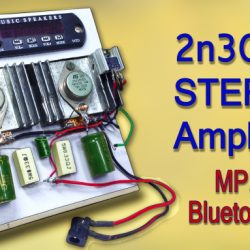
Introduction
A subwoofer amplifier plays a vital role in enhancing the bass response and overall audio quality of a sound system. If you are looking to build your own subwoofer amplifier circuit, then you have come to the right place. In this article, we will discuss a subwoofer amplifier circuit diagram using the TL072 and TDA1521 ICs, two widely used integrated circuits known for their excellent performance in audio applications.
TL072 IC Specification:
The TL072 is a dual operational amplifier integrated circuit commonly used in audio and other low-frequency applications. It features low noise and distortion, high input impedance, and a wide bandwidth. The TL072 also has a high slew rate, which enables it to accurately reproduce fast-changing audio signals. This IC is well-suited for use in audio amplifier circuits, including subwoofer applications.
TDA1521 IC Specification:
The TDA1521 is a stereo audio power amplifier IC known for its high output power and superior audio performance. It is specifically designed for use in car audio systems but can also be utilized in other audio applications. The TDA1521 features a three-point digital volume control, built-in thermal shutdown protection, and short-circuit protection. With its high power capabilities and advanced protection features, the TDA1521 is an excellent choice for driving subwoofers.
Subwoofer Amplifier Circuit using TL072 & TDA1521 ICs
This project can be built using a few basic components. The circuit diagram of this project is shown below.
12V Power Supply Circuit Diagram
More Circuit Layouts








Components List of Subwoofer Amplifier Circuit using TL072
Following is the list of all components used in this project:
- TL072 IC x 1
- TDA1521 IC x 1
- 47k Resister x 5
- 10 Ohms Resister x 2
- 100k Resister x 1
- 50k Potentiometer x 2
- 4.7uF Capacitor x 1
- 0.027uF Capacitor x 1
- 0.22uF Capacitor x 3
- 0.068uF Capacitor x 1
- 3300pF Capacitor x 1
- 0.01uF Capacitor x 1
- 0.1uF Capacitor x 2
- 12V Power Supply
Working Explanation of Subwoofer Amplifier Circuit using TL072
Now let’s dive into the subwoofer amplifier circuit diagram using the TL072 and TDA1521 ICs. This circuit combines the benefits of both ICs to deliver a powerful and clean bass output. The TL072 is employed as a preamplifier stage, while the TDA1521 serves as the main power amplifier.
Here’s a simplified overview of the circuit:
- The TL072 IC is connected in a standard inverting amplifier configuration to amplify the audio signal from the input source.
- The amplified signal is then fed into the TDA1521 IC, which further boosts the signal power to drive the subwoofer speaker.
- The TDA1521 IC’s output is connected to the subwoofer speaker, providing the necessary power to produce deep and impactful bass.
Conclusion
Building your own subwoofer amplifier circuit can be a rewarding experience, allowing you to customize the audio performance of your sound system according to your preferences. The TL072 and TDA1521 ICs are ideal choices for this purpose, offering excellent audio quality, power capabilities, and protection features.
By following the provided circuit diagram and utilizing these ICs in your amplifier design, you can achieve impressive bass response and audio fidelity. Enjoy a deeper, more immersive listening experience with your newly constructed subwoofer amplifier circuit.
More projects, You may like:
- Video Transmitter DIY Homemade FM Radio Transmitter
- Adjustable Power Supply DIY Battery Charger
- 12V-220V 500 Watt inverter DIY Homemade
- 12V-220V H-Bridge Inverter DIY Homemade
- MPPT Solar Charge Controller DIY Homemade
- 18650 battery bank free charge protection module
- D718 B688 Bass Amplifier Homemade DIY
- C5200 Bass Amplifier DIY Homemade with Volume
- DIY LA4440 bass amplifier homemade
- C5200 A1943 TDA2030 Amplifier DIY Homemade
For more project and circuit diagrams, you can go through the Schematics in the main menu where you can find many interesting projects and circuit diagrams like audio amplifier circuits, voltage booster circuit, battery charger circuit and timer circuits etc., which are all beginner circuit projects. Feel free to check them out!


Thank you for visiting the article.



























